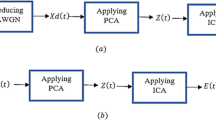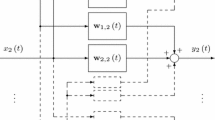Abstract
We have shown previously that non-stationary signals recorded in a static multi-path environment can often be recovered by simultaneously decorrelating varying second order statistics. As typical sources are often moving, however, the multi-path channel is not static. We present here an on-line gradient algorithm with adaptive step size in the frequency domain based on second derivatives, which we refer to as multiple adaptive decorrelation (MAD). We compared the separation performance of the proposed algorithm to its off-line counterpart and to another decorrelation based on-line algorithm.
Similar content being viewed by others
References
E. Weinstein, M. Feder, and A.V. Oppenheim, “Multi-Channel Signal Separation by Decorrelation,” IEEE Trans. Spreech Audio Processing, vol. 1, no.4, 1993, pp. 405–413.
S. Van Gerven and D. Van Compernolle,“Signal Separation by Symmetric Adaptive Decorrelation: Stability, Convergence, and Uniqueness,” IEEE Trans. Signal Processing, vol. 43, no.7, 1995, pp. 1602–1612.
K.-C. Yen and Y. Zhao, “Improvements on Co-Channel Separation using ADF: Low Complexity, Fast Convergence, and Generalization,” in Proc. ICASSP 98, Seattle, WA, 1998, pp. 1025–1028.
M. Kawamoto,“A Method of Blind Separation for Convolved Non-Stationary Signals,” Neurocomputing, vol. 22, no.1-3, 1998, pp. 157–171.
S. Van Gerven and D. Van Compernolle, “Signal Separation in a Symmetric Adaptive Noise Canceler by Output Decorrelation,” in Proc. ICASSP 92, 1992, vol. IV, pp. 221–224.
D. Yellin and E. Weinstein, “Multichannel Signal Separation: Methods and Analysis,” IEEE Trans. Signal Processing, vol. 44, no.1, 1996, pp. 106–118.
H.-L.N. Thi and C. Jutten, “Blind Source Separation for Convolutive Mixtures,” Signal Processing, vol. 45, no.2, 1995, pp. 209–229.
V. Capdevielle, C. Serviere, and J.L. Lacoume, “Blind Separation of Wide-Band Sources in the Frequency Domain,” in Proc. ICASSP 95, 1995, pp. 2080–2083.
S. Shamsunder and G. Giannakis, “Multichannel Blind Signal Separation and Reconstruction,” IEEE Trans. Speech Audio Processing, vol. 5, no.6, 1997, pp. 515–528.
S. Cruses and L. Castedo, “A Gauss-Newton Method for Blind Separation of Convolutive Mixtures,” in Proc. ICASSP 98, Seattle, WA, 1998.
R. Lambert and A. Bell, “Blind Separation of Multiple Speakers in a Multipath Environment,” in Proc. ICASSP 97, 1997, pp. 423–426.
S. Amari, S.C. Douglas, A. Cichocki, and A.A. Yang, “Multichannel Blind Deconvolution Using the Natural Gradient,” in Proc. 1st IEEE Workshop on Signal Processing App. Wireless Comm., 1997, pp. 101–104.
T. Lee, A. Bell, and R. Lambert, “Blind Separation of Delayed and Convolved Sources,” in Proc. NIPS 96, 1997.
L. Parra, C. Spence, and B. De Vries, “Convolutive Blind Source Separation Based on Multiple Decorrelation,” in IEEE Workshop on Neural Networks and Signal Processing, Cambridge, UK, September, 1998, also presented at ‘Machines that Learn’ Workshop, Snowbird, April 1998.
L. Parra and C. Spence, “Convolutive Blind Source Separation of Non-Stationary Sources,” IEEE Trans. Speech Audio Processing, vol. 8, no.3, pp. 320–327.
J. Principe, “Simultaneous Diagonalization in the Frequency Domain (SDIF) for Source Separation,” in ICA'99, Cardoso, Jutten and Loubaton (Eds.), 1999, pp. 245–250.
K.-C Yen and Y. Zhao, “Adaptive Co-Channel Speech Separation and Recognition,” IEEE Trans. Signal Processing, vol. 7, no.2, 1999.
S. Amari, C.S. Douglas, A. Cichocki, and H.H. Yang, “Novel On-Line Adaptive Learning Algorithms for Blind Deconvolution Using the Natural Gradient Approach,” in Proc. 11th IFAC Symposium on System Identification, Kitakyushu City, Japan, July 1997, vol. 3, pp. 1057–1062.
P. Smaragdis, “Blind Separation of Convolved Mixtures in the Frequency Domain,” Neurocomputing, vol. 22, 1998, pp. 21–34.
T. Ngo and N. Bhadkamkar, “Adaptive Blind Separation of Audio Sources by a Physically Compact Device Using Second-Order Statistics,” in ICA'99, Loubaton Cardoso, and Jutten (Eds.), 1999, pp. 257–260.
H. Sahlin and H. Broman, “Separation of Real-World Signals,” Signal Processing, vol. 64, 1998, pp. 103–104.
P. Nelson, F. Orduna-Bustamante, and H. Hamada, “Inverse Filter Design and Equalization Zone in Multichannel Sound Reproduction,” IEEE Trans. Speech Audio Processing, vol. 3, no.3, 1995, pp. 185–192.
D. Brandwood, “A Complex Gradient Operator and Its Application in Adaptive Array Theory,” IEE Proc., vol. 130, no.1, 1983, pp. 11–16.
P.M. Peterson, “Simulating the Response of Multiple Microphones to a Single Acoustic Source in a Reverberant Room,” J. Acoust. Soc. Am., vol. 80, no.5, 1986, pp. 1527–1529.
Author information
Authors and Affiliations
Rights and permissions
About this article
Cite this article
Parra, L., Spence, C. On-line Convolutive Blind Source Separation of Non-Stationary Signals. The Journal of VLSI Signal Processing-Systems for Signal, Image, and Video Technology 26, 39–46 (2000). https://doi.org/10.1023/A:1008187132177
Published:
Issue Date:
DOI: https://doi.org/10.1023/A:1008187132177




